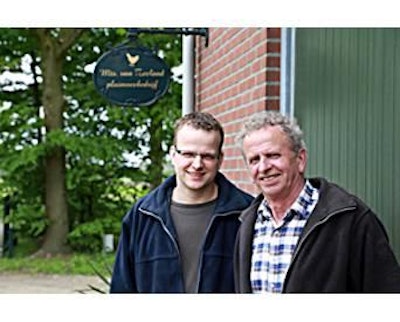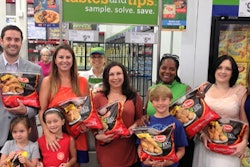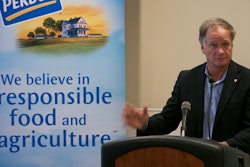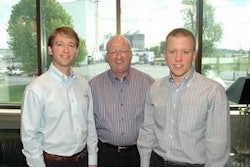
What's good for the environment can be good for profits too. This has turned out to be the experience of the Van Zeeland family from Brabant, the Netherlands, who are raising broilers and making the most of natural resources.
The family has been raising broilers since the late 1960s, but for almost a decade now they have been doing something a little different -- making use of the heat that is present in groundwater and reusing heat generated by their birds. They have seen their expenses drop and the health of their birds improve.
Jan van Zeeland started poultry production back in 1968 on a site close to where he currently rears birds, but poultry production at the former site could not continue due to the area being redesignated as a housing zone. Although these plans were eventually abandoned due to environmental concerns, the Van Zeeland family moved their production and gave up their original two poultry houses.
Better things to come
In 1980, the family constructed the first new poultry houses, and they now raise 644,000 birds a year. However, it was not until 2004 that the new, sustainable and cost-saving approach to rearing was introduced. It was decided to build a poultry house using the TerraSea concept. This was followed by a second shed, following the same principles, but with slight modifications. The family how has four poultry houses: two traditional and two following the new approach.
There were a number of factors influencing the decision to move into more environmentally friendly production. By 2004, any expansion at the site was required by law to have an air-cleaning system, but installation and running come at a cost.
Energy savings
Jan's 34-year-old son Eric explains: "The family wanted to expand production, but this had to comply with environmental regulations.
"We could have simply opted for a chemical air washer, but there is a continuing expense with that. The route that we decided to take, however, allows us to save money on an ongoing basis, and it means that the air washing system that we have is actually smaller. Conditioning our incoming means that we need to ventilate less and so the air washer can be smaller."
Deciding to adopt energy-saving green practices was not a question of this generation leading the previous; despite a difference in age, there was agreement between father and son.
"We think along the same lines, and we are completely independent from anyone else, so we can move the business in whatever direction we think best," says Eric.
The ideas were developed by the father and son together, and Inno+ and Stienen BE were called in to jointly develop the concept and system.
Natural resources
What was constructed at the site is called the TerraSea concept. It uses natural resources, such as heat generated below ground or in the poultry house itself, to control ventilation, cooling and heating. A constant climate is achieved within the poultry house, and along with low-maintenance air scrubbing, this results in energy savings of 60 percent in comparison with conventional climate systems.
Eric adds: "We wanted to take into account rising energy costs. Before, we had to spend a lot on gas if it was too cold, and if it was too warm, the birds would not grow. Keeping your incoming air the same eliminates this."
The system installed by the Van Zeelands makes use of geothermal energy for cooling and heating by tapping into ground water four meters below the surface. Ground heat can be used to warm the incoming air, which is used for ventilation, and heat blown out of the house is recuperated by the air scrubber. The scrubber reduces smell by 45 percent, dust by 35 percent and ammonia by 70-95 percent.
The house uses a cross flow ventilation system. Along the left side of the building runs a corridor with a heat exchanger -- banks of water-containing pipes -- and this is where the air first enters. From there, it enters the main part of the house via traditional inlet valves and ventilates between the birds rather than above before exiting via exhaust points. Everything is very much hands-off -- a computer can choose from where it will draw energy and to where it needs to be delivered, so the natural resources available at the site are all very carefully and precisely controlled. In addition, these controllers are all plug and play, so if something needs to be repaired, it can be carried out off-site, minimizing the risk of pathogens entering the house.
The poultry house has underfloor heating to keep chicks warm during the first 10 days of life.
Eric notes: "The chicks spread out evenly in the house when they arrive, just like planted seeds, as there is no need to huddle together. Birds tell you when they are doing OK."
Fluctuation to constancy
The system is able to compensate for peaks and troughs in the outside environment, thus preventing temperature fluctuations inside the house. Due to conditioning of the floor, litter is also of optimal quality, and this contributes to bird health.
"The one thing that you don't want with birds is draught," says Eric. "With this system there is no draught, and the temperature is the same day and night."
The system has brought down running costs, but careful control of the poultry house's climate has also resulted in other benefits.
Eric notes that birds reared in a constant temperature are heavier and healthier.
"When the birds do well, we can work without veterinary medicines," he says. "If there should be a health problem, then we know that it must have come from the chick supplier."
This improved health status is also evident when the farm's footpad lesions score is examined. The Van Zeelands manage to achieve foot pad lesion scores of 13.5 compared to an average score of 30-40 on good poultry farms in the area.
Because the birds are kept in an optimal environment, cheaper diets can be used that contain less wheat, and this further helps to keep costs down. When the Van Zeelands first adopted the system, they thought that feed would have to contain higher levels of protein, but this turned out not to be the case.
The Van Zeeland family raises seven batches of Ross 308 chicks, sourced from a local supplier, with 7-10 days downtime between each batch. There are 92,000 birds on the farm at any one time, which are reared for 43 days with a weight of 2.4-2.4 kg. Litter is changed between batches and houses washed and disinfected by the Van Zeelands themselves. However, they have to pay for disposal of litter, which is mixed with horse manure and straw, and then it is used on mushroom farms.
Future directions
The first two modern houses were built by the father and son working with contractors. They could build a fifth house, as there is permission to rear 140,000 birds on the site, but this is not in their immediate plans. Instead, the traditional houses will be demolished, and replaced using the climate-control concept.
They have tried to increase ventilation in their traditional buildings, but this has resulted in higher energy costs, so the best way forward is seen as replacement. For the time being, rather than expansion, they believe the best self-improvement is optimizing what they have.


















